Social action drives meaningful change by empowering individuals and communities to address shared challenges and promote justice. It encompasses a range of activities, from grassroots organizing to advocacy and volunteerism, fostering collective responsibility and social cohesion. Discover how your involvement in social action can make a lasting impact by exploring the rest of the article.
Table of Comparison
| Aspect | Social Action | Social Fact |
|---|---|---|
| Definition | Individual or group behavior with subjective meaning aiming to influence others. | Objective, external social phenomena shaping individual behavior. |
| Origin | Max Weber's interpretive sociology. | Emile Durkheim's sociological framework. |
| Nature | Subjective, intentional actions. | External, coercive social structures. |
| Focus | Meaning and purpose behind actions. | Established social norms, values, and institutions. |
| Function in society | Shapes social interaction and cultural meanings. | Maintains social order and collective conscience. |
| Examples | Protests, voting, rituals with intention. | Laws, language, religious beliefs as societal facts. |
Defining Social Action: Core Concepts
Social action refers to behaviors and activities undertaken by individuals that carry subjective meaning and are oriented towards others within a social context. Max Weber emphasizes intention and rationality, categorizing social actions into four types: traditional, affective, value-rational, and instrumental. These core concepts highlight how social actions shape and are shaped by individual motives and societal interactions.
Understanding Social Fact: Key Principles
Understanding social fact involves recognizing it as external, constraining realities that exist independent of individual choices, rooted in collective norms, values, and institutions that shape behavior within a society. Social facts operate as objective phenomena that guide social action, emphasizing patterns and rules observable through empirical study rather than personal intentions or motivations. Key principles include their coercive power over individuals, their generality across groups, and their existence prior to and beyond any single person's influence, making them fundamental to social structure analysis.
Origins: Max Weber vs. Émile Durkheim
Max Weber originated the concept of social action, emphasizing individual intentions and meanings behind behaviors within society. Emile Durkheim introduced the idea of social facts, focusing on external, collective forces shaping individual actions regardless of personal intentions. These foundational contributions highlight Weber's interpretive sociology versus Durkheim's structural functionalism in understanding social phenomena.
Methodological Approaches: Interpretive vs. Positivist
Social action in the interpretive methodological approach emphasizes understanding individual motivations and subjective meanings behind behaviors through qualitative analysis and empathetic engagement. Social fact in the positivist approach treats societal phenomena as objective, external realities measurable by quantitative methods, prioritizing observable data and generalizable laws. This contrast highlights the interpretive focus on agency and context versus the positivist pursuit of patterns and causality within social structures.
Types of Social Action Explained
Max Weber identifies four types of social action: instrumental-rational, value-rational, affectual, and traditional, each distinguished by the actor's motivation and goal orientation. Instrumental-rational action focuses on calculated means to achieve specific ends, while value-rational action is driven by belief in the intrinsic value of behavior regardless of outcome. Affectual action arises from emotional states, and traditional action is guided by ingrained habits or customs, contrasting with Durkheim's concept of social facts, which are external, coercive societal norms shaping individual behavior.
Characteristics of Social Facts
Social facts are external, coercive elements that shape individual behavior within a society, existing independently of personal consciousness. They manifest through collective norms, values, laws, and customs that regulate social life and maintain social order. Unlike social actions driven by individual intentions, social facts exert influence through established societal structures and expectations.
Examples: Social Action in Everyday Life
Social action refers to individual behaviors motivated by meanings and intentions, such as greeting a colleague to build rapport or participating in a community cleanup to promote environmental awareness. Social facts, by contrast, are external societal norms and structures that influence behavior, like laws against littering or cultural expectations of politeness. Examples of social action in everyday life demonstrate how personal motivations interact with social facts, shaping interactions and societal patterns.
Examples: Social Facts Shaping Society
Social facts, such as laws, traditions, and social norms, exert an external force that shapes individual behavior and societal structures, evident in legal systems enforcing compliance and cultural customs guiding social interactions. In contrast, social actions are individual or collective behaviors driven by personal motives or responses to these social facts, like protests challenging unjust laws or grassroots movements promoting social change. Examples include the influence of religious beliefs dictating marriage customs as social facts, while social actions involve individuals advocating for gender equality within those traditions.
Comparative Analysis: Social Action vs. Social Fact
Social action emphasizes individual intentions and meanings behind behaviors, analyzing how personal motives shape social interactions. Social facts represent external, coercive structures and norms that exist independently of individual will, influencing behavior through societal pressure. Comparative analysis reveals social action as subjective and dynamic, while social fact is objective, stable, and constraining within the social system.
Implications for Sociological Research
Social action focuses on individual behaviors and subjective meanings, requiring qualitative methods like interviews and participant observation to capture personal motives and intentions. Social fact emphasizes external, objective social structures and norms, favoring quantitative approaches such as surveys and statistical analysis to identify broad patterns. Recognizing the distinction guides researchers in selecting appropriate methodologies that align with their focus on either subjective experiences or objective social phenomena.
Social action Infographic

 libterm.com
libterm.com